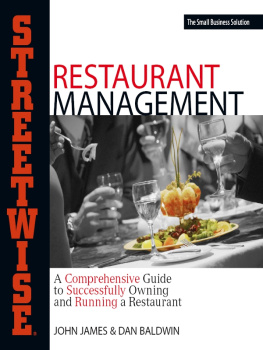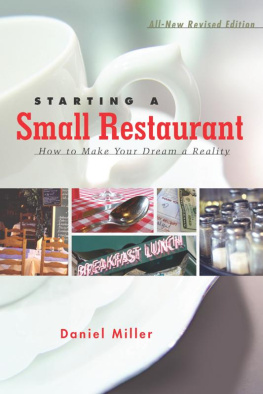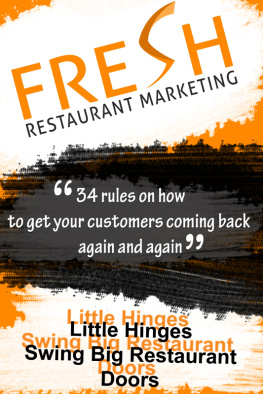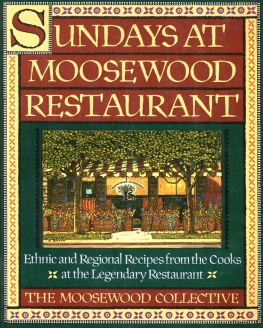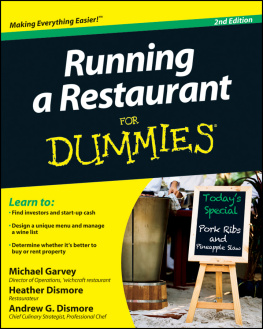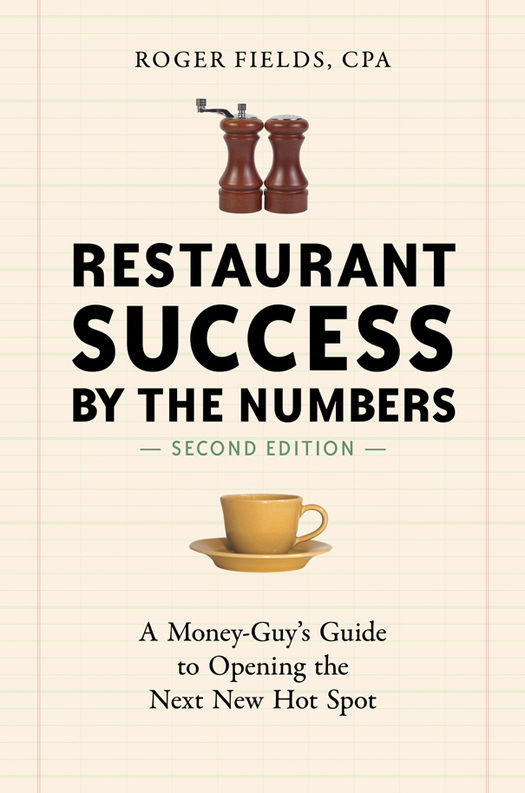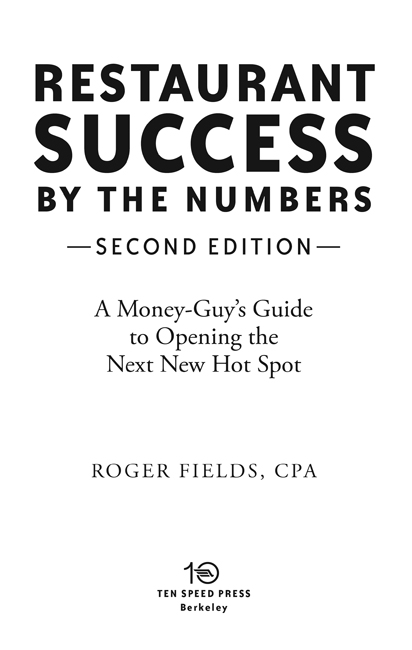Copyright 2007, 2014 by Roger Fields
Front cover photos by Punchstock/Jupiter Images (top) and Katy Brown (bottom)
All rights reserved. Published in the United States by Ten Speed Press, an imprint of the Crown Publishing Group, a division of Random House LLC, a Penguin Random House Company, New York.
www.crownpublishing.com
www.tenspeed.com
Ten Speed Press and the Ten Speed Press colophon are registered trademarks of Random House LLC.
Library of Congress has catalogued the first edition as follows:
Fields, Roger.
Restaurant success by the numbers : a money-guys guide to opening the next new hot spot / Roger Fields.
p. cm.
Includes bibliographical references and index.
ISBN-13 : 978-1-58008-663-9 (pbk.)
1. Restaurant management. I. Title.
TX911.3.M27F54 2007
647.95068dc22 2007010637
Trade Paperback ISBN: 978-1-60774-558-7
eBook ISBN: 978-1-60774-559-4
Original cover design by Katy Brown
Front cover photo (bottom) props courtesy
Williams-Sonoma, Inc., www.williams-sonoma.com
v3.1
CONTENTS
Introduction
Just before I wrote the first edition of this book, I went to a doctors office to get my eyes checked. After reviewing the patient info sheet and observing that Id been a restaurant owner for a number of years, the ophthalmologist proceeded to tell me how fortunate I was to have lasted in such a difficult business for so long. When I told him that it was not all that bad, he would have no part of it. And when I asked him where he got his information, he told me emphatically, Its a well-known fact that 80 to 90 percent of all restaurants fail in the first year. Given the popularity of restaurant reality TV shows, one would have thought that by now this myth would have faded somewhat, but sadly it hasnt. Just recently, while channel surfing one Sunday morning, I came across a business program called Press:Here on NBC, where Luanne Calvert, vice president of Virgin America, was the featured guest. During the discussion, which focused on Virgin Americas inability to turn a profit, the host of the show, Scott McGee, pointed out to Ms. Calvert that the last time David Cush, the then CEO of Virgin America, was on his show he lamented how hard it was to make money in the airline business and cautioned him never, never, never start an airline or (you guessed it!) open a restaurant! I dont suppose Mr. Cush is aware of Chipotle Mexican Grill, which started out as a burrito joint and is now a multibillion-dollar publicly traded company generating record profits every year!
Since this perception has not changed, once again I am going to have to kick things off with a warning, because, as youll soon find out, unfortunately this is how most of your early conversations about opening your own restaurant will start, too. I want you to be prepared and, more important, resolute. As you can see, the restaurant business still has a bad rapone that it definitely does not deserve.
THE 90 PERCENT MYTH
There are actually two myths about restaurant success: the one my not-so-insightful doctor as well as the CEO of Virgin America shared and its ugly stepsister, the notion that the 10 percent of restaurants that do succeed, do so only because of luck, otherwise known as the X factor. Lets start with the 90 percent bit.
Yes, your naysayer friends may have seen the caution printed in restaurant textbooks or in industry periodicals, or maybe they saw it on reality television shows. Remember when Rocco DiSpirito of The Restaurant reality show lamented, The inventory is highly perishable, the overhead insaneits no wonder that about 90 percent of all restaurants fail in the first year. But listen carefully (you too, Rocco!): there is absolutely no evidence to support this much-cited failure rate. In fact, evidence points to the opposite.
A 2003 study found a restaurant failure rate of only 59 percent over a three-year period. The studys author, Ohio State University hospitality management professor Dr. H. G. Parsa, studied 2,439 restaurants in Columbus, Ohio, using local health department data for the 1996 to 1999 period. Even including restaurants that closed for reasons other than financesfor example, divorce or retirementParsa found failure rates of only 26 percent in the first year, 19 percent in the second, and 14 percent in the third. After an extensive literature review on restaurant failures, I can find no evidence of a 90 percent failure rate anywhere, he concluded.
What? However, those nattering nabobs of negativism still arent satisfied. Columbus, Ohio, doesnt exactly have the same competition as New York or San Francisco, nor even the challenges faced in Washington, D.C., or Portland, Oregon. Well, these findings are consistent with an earlier study by Professor Chris Muller of the Cornell University School of Hotel Administration. He found that approximately 33 percent of all restaurants in the United States fail in the first year of operation. Thats a far cry from 90 percent. Another 33 percent of those remaining fail in the second year. But once past that crucial starting period, 65 percent of the restaurants that make it through their third year will survive for ten years. Professor Mullers study also found that only 10 percent of franchised restaurants failed in the first year, and 85 percent were still operating under the same ownership after five years.
More encouraging is the Dun & Bradstreet survey of businesses that went bankrupt or closed with unpaid obligations between 1920 and 1998. It found that eating and drinking places had a failure rate of only about 1.06 percent!
The fact is, not only do restaurants not have the highest failure rate of all businesses, they actually compare exceedingly well. According to Dun & Bradstreet, apparel, furniture, and camera and electronic stores are all more likely to fail than restaurants. And things just keep getting better. Read on.
AN EVEN BRIGHTER FUTURE
As more and more Americans move to cities, they have less time and space to cook. People need a convenient way to eat when they come home from work. At the same time, meals are still social occasionstimes when friends or families get together. But fewer people these days have the energy to cook a big group meal and then actually enjoy it, especially knowing there will be dishes to wash after the guests have gone home. So what do Americans do? They go out to eat, of course!
In the United States, restaurants and food services together make up the nations largest retail sector. According to the National Restaurant Association, total restaurant-and-food service sales are projected to reach $683.4 billion at more than nine hundred and ninety thousand locations in 2014. Whats remarkable about these numbers is that, despite the great recession, which started in late 2007, restaurant sales would have increased by $146.4 billion and ninety thousand new locations will be added.
Consider these facts as well:
According to a report released by Bank of America Merrill Lynch late in 2011, since 2009 consumers have been spending more of their paychecksnow almost 4.5 percenton dining out. The report went on to note that, while spending on restaurants has increased over the same period, spending on groceries remained flat. One of the reasons is that, because of rising commodity prices, supermarket food prices are increasing at an astonishing 6 percent per year, which is approximately 2.5 times as fast as restaurant meals. As the number of American households earning two incomes grows, parents will have less time to prepare meals at home and thus will demand more dining conveniences. The popular Zagat restaurant guide has even coined a term for restaurants that cater to customers who choose to go out for everyday meals: Better Alternative to Home, or BATH. The National Restaurant Associations 2012 Industry Forecast reported the following: pent-up demand for restaurant services is substantial, with two out of five consumers saying that they are not using restaurants as often as they would like; the restaurant industrys share of the food dollar is now 47 percent; 90 percent of American adults reported that they enjoy going to restaurants; 66 percent of adults said their favorite restaurant foods provide flavor and taste sensations that they cannot easily duplicate at home; and the average household expenditure on food away from home in 2010 was $2,505. Also, a 2012 Gallup poll found that consumers who eat out of their homes spend an average of $150 per week.


